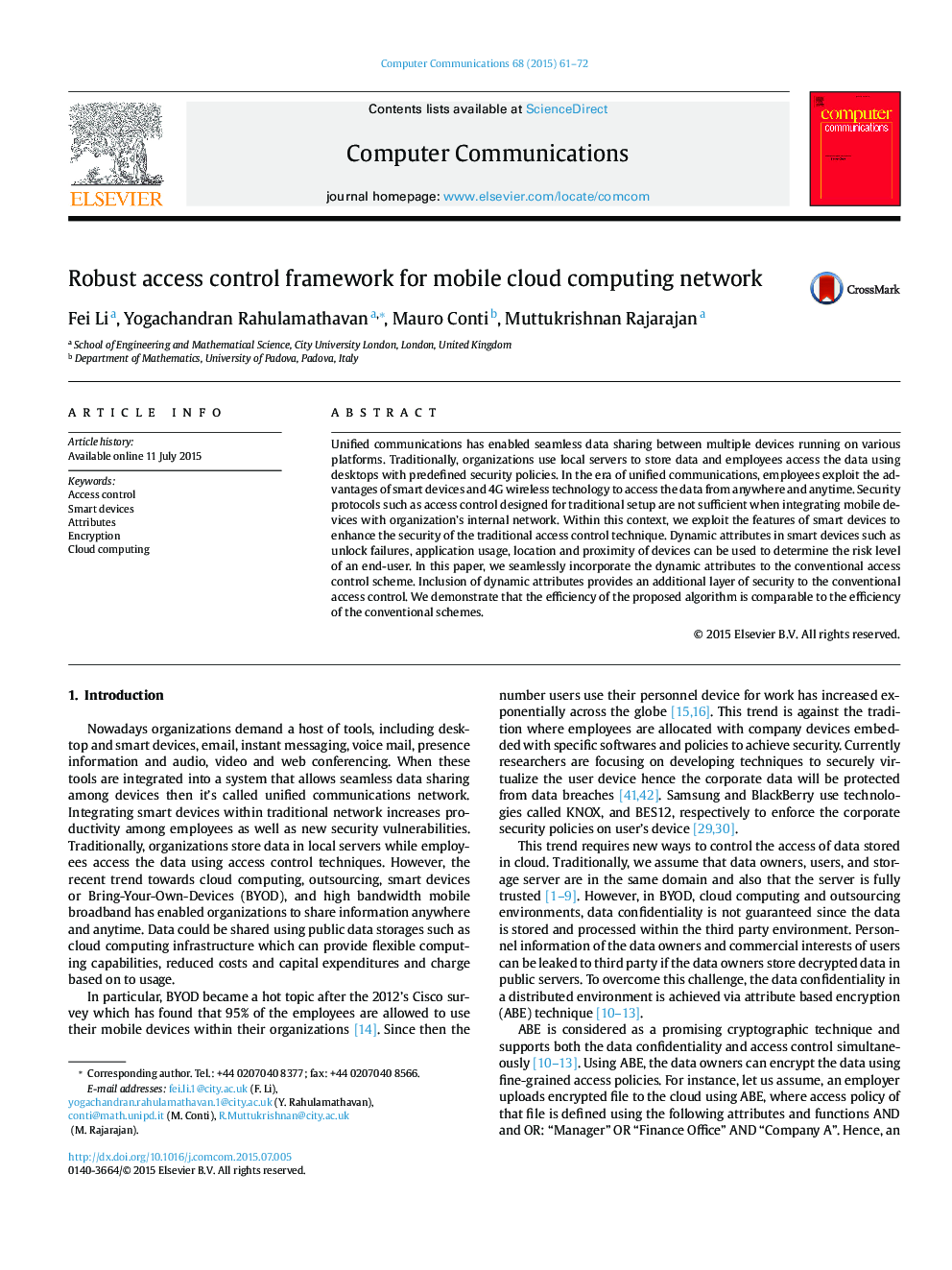| کد مقاله | کد نشریه | سال انتشار | مقاله انگلیسی | نسخه تمام متن |
|---|---|---|---|---|
| 445771 | 693246 | 2015 | 12 صفحه PDF | دانلود رایگان |
کلیدواژهها
1.مقدمه
2: کارهای مرتبط
جدول 1:مقایسه کارهای مرتبط.کار پیشنهادی ما در مقایسه با کارهای دیگر صفت های بیشتری را یکپارچه سازی می کند
شکل 1: طرح ABE تک منبع موثق
3: بیان مسئله
3.1: معماری سیستم
3.2: رمزگشایی مبتنی بر صفت
3.3: تهدیدات امنیتی و حریم خصوصی
شکل 2:معماری الگوریتم پیشنهادی در سطح بالا
4: طرح رمزنگاری مبتنی بر صفت ایستا و پویا برای تک AA
4.1: فرضیات و اصول طراحی
4.1.1. ویژگی پویا
4.1.2. مقدمات
4.1.3 فرض پیچیدگی
4.2: طرح پیشنهادی
4.3: بازی امنیتی
شکل 3. مربوط است به طرح رمزنگاری مبتنی بر صفات پویا و ایستا برای تک AA
5: طرح رمزنگاری مبتنی بر صفات پویا و ایستا برای منبعهای صفات متعدد
شکل 4. طرح الگوریتم رمزنگاری مبتنی بر صفات پویا و ایستا برای منبع موثق های صفات متعدد را نشان میدهد.
6.تجزیهوتحلیل عملکرد
جدول 2: تدابیر پیچیدگی زمان را برای دو تست بد تفاوت نشان میدهد.
6.1. پیچیدگی محاسباتی
جدول 3 .مقایسه هزینههای محاسباتی را برای طرح ABE تک منبع موثق را با طرح پیشنهادی ارائه میکند
جدول 4. مقایسه هزینههای محاسباتی را برای طرح ABE چند منبع موثق را با طرح پیشنهادی ارائه میکند
شکل 5. پیچیدگی محاسباتی را برای مورد طرح تک منبع موثق نشان میدهد: خط سیاه طرح پیشنهادی است و خط آبی طرح ABE است.
6.2: پیچیدگی ارتباط ها
شکل 6. مقایسه پیچیدگی محاسباتی را برای بیش از یک AA نشان میدهد.
7: امنیت و تجزیه وتحلیل حریم خصوصی
7.1 برطرف کردن خطرات هویتی
7.2 برطرف کردن خطرات مربوط به حریم خصوصی
7.3: برطرف کردن حملات تصادم
7.4برطرف کردن تقلب صفت پویا
شکل7:در طرح ما اگر تعداد بیشتری صفات در حین رمزنگاری یکپارچه شود،می توان پیچیدگی محاسباتی را کاهش داد
7.6. تجزیه و تحلیل امنیت
8.نتیجهگیری، محدودیتها و کارهای بعدی
8.1محدودیتها و کارهای بعدی
• We propose robust access control framework for a network which has allowed smart devices to be connected to the internal network in order to enable seamless data sharing.
• Smart device’s sensor data such as location, app usage pattern, unlock failures are being considered for access control and data confidentiality
• These sensor data and conventional static credentials are combined to develop a secure framework which verifies the users access privileges in run-time
• The algorithm supports both the access control and data confidentiality simultaneously.
• Algorithms are validated via simulation and the results show that the performance is comparable with existing schemes.
• Existing schemes are thoroughly surveyed and different between proposed and existing schemes are clearly highlighted.
Unified communications has enabled seamless data sharing between multiple devices running on various platforms. Traditionally, organizations use local servers to store data and employees access the data using desktops with predefined security policies. In the era of unified communications, employees exploit the advantages of smart devices and 4G wireless technology to access the data from anywhere and anytime. Security protocols such as access control designed for traditional setup are not sufficient when integrating mobile devices with organization’s internal network. Within this context, we exploit the features of smart devices to enhance the security of the traditional access control technique. Dynamic attributes in smart devices such as unlock failures, application usage, location and proximity of devices can be used to determine the risk level of an end-user. In this paper, we seamlessly incorporate the dynamic attributes to the conventional access control scheme. Inclusion of dynamic attributes provides an additional layer of security to the conventional access control. We demonstrate that the efficiency of the proposed algorithm is comparable to the efficiency of the conventional schemes.
Journal: Computer Communications - Volume 68, 1 September 2015, Pages 61–72
